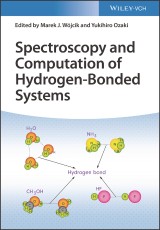Details

Spectroscopy and Computation of Hydrogen-Bonded Systems
1. Aufl.
|
160,99 € |
|
| Verlag: | Wiley-VCH |
| Format: | |
| Veröffentl.: | 07.12.2022 |
| ISBN/EAN: | 9783527834891 |
| Sprache: | englisch |
| Anzahl Seiten: | 544 |
DRM-geschütztes eBook, Sie benötigen z.B. Adobe Digital Editions und eine Adobe ID zum Lesen.
Beschreibungen
<b>Spectroscopy and Computation of Hydrogen-Bonded Systems</b> <p><b>Comprehensive spectroscopic view of the state-of the-art in theoretical and experimental hydrogen bonding research</b> <p><i>Spectroscopy and Computation of Hydrogen-Bonded Systems</i> includes diverse research efforts spanning the frontiers of hydrogen bonding as revealed through state-of-the-art spectroscopic and computational methods, covering a broad range of experimental and theoretical methodologies used to investigate and understand hydrogen bonding. The work explores the key quantitative relationships between fundamental vibrational frequencies and hydrogen-bond length/strength and provides an extensive reference for the advancement of scientific knowledge on hydrogen-bonded systems. <p>Theoretical models of vibrational landscapes in hydrogen-bonded systems, as well as kindred studies designed to interpret intricate spectral features in gaseous complexes, liquids, crystals, ices, polymers, and nanocomposites, serve to elucidate the provenance of spectroscopic findings. Results of experimental and theoretical studies on multidimensional proton transfer are also presented. <p>Edited by two highly qualified researchers in the field, sample topics covered in <i>Spectroscopy and Computation of Hydrogen-Bonded Systems</i> include: <ul><li> Quantum-mechanical treatments of tunneling-mediated pathways and molecular-dynamics simulations of structure and dynamics in hydrogen-bonded systems</li> <li> Mechanisms of multiple proton-transfer pathways in hydrogen-bonded clusters and modern spectroscopic tools with synergistic quantum-chemical analyses</li> <li> Mechanistic investigations of deuterium kinetic isotope effects, ab initio path integral methods, and molecular-dynamics simulations</li> <li> Key relationships that exist between fundamental vibrational frequencies and hydrogen-bond length/strength</li> <li> Analogous spectroscopic and semi-empirical computational techniques examining larger hydrogen-bonded systems</li></ul> <p>Reflecting the polymorphic nature of hydrogen bonding and bringing together the latest experimental and computational work in the field, <i>Spectroscopy and Computation of Hydrogen-Bonded Systems</i> is an essential resource for chemists and other scientists involved in projects or research that intersects with the topics covered within.
Fundamentals<br> 1. Quantum statistical theory of the IR spectra band profiles of weak cyclic H-bonded systems <br> 2. Dynamic Interactions Shaping Vibrational Spectra of Hydrogen-Bonded Systems<br> 3. Vibrational fingerprints of weak interactions from fully anharmonic computations: success and challenges <br> 4. Dynamics of proton motion in intramolecular hydrogen bonds studies by molecular dynamics <br> 5. On the fly molecular dynamics approach to the tunneling splitting due to intramolecular proton transfer <br> <br> Spectroscopy<br> 6. Imaging hydrogen-bond structure dynamics with MeV-UED <br> 7. Spectroscopic Signatures of Low-Barrier Hydrogen Bonding in Neutral Species <br> 8. Excess spectroscopy of hydrogen bond<br> 9. Intramolecular hydrogen bonding in porphyrin isomers <br> 10. Isotope effects in hydrogen bond research<br> 11. Atomic and molecular complexes of noble gas hydrides <br> 12. Relevance of intramolecular interactions in shaping the potential energy surfaces and the reactivity of a series of substituted aromatic molecules <br> 13. Hydrogen bonding studies by overtones and combinations <br> 14. Direct observation and kinetic mapping of point-to-point proton transfer of a hydroxy-photoacid to multiple (competing) intramolecular protonation sites <br> 15. Stories that are encoded in vibrational spectra: Obtaining insights into the spectroscopy of water from studies of ion-water complexes<br> 16. Molecular beam microwave spectroscopic investigation of hydrogen bonds in isolation <br> 17. IR and NMR spectral diagnostics of hydrogen bond energy and geometry<br> 18. Far-ultraviolet spectroscopy studies of hydrogen bonds<br> 19. Water hydrogen bond network and hydrophobic effect<br> 20. Hydrogen-bonded chains in foldamer structure and dynamics<br>
<p><i><b>Professor Marek J. Wójcik</b> received his PhD and habilitation from Jagiellonian University, Poland. His important contributions include quantum-mechanical models for spectra of hydrogen-bonded systems, theoretical modeling of vibrational spectra of water, aqueous ionic solutions and ices, theoretical studies of multidimensional proton tunneling, Car-Parrinello and Born-Oppenheimer simulations of spectra of hydrogen-bonded crystals. </i> <p><i><b>Professor Yukihiro Ozaki</b> received his PhD in 1978 from Osaka University, Japan. He is Professor Emeritus and University Fellow of Kwansei Gakuin University. He has guest professor or scientist positions at Peking University, Kobe University, Riken, and Toyota Physical and Chemical Research Institute. He has been involved in studies of a wide range of molecular spectroscopy, covering from far-ultraviolet to far-infrared/Terahertz spectroscopy and Raman spectroscopy.</i>
<p><b>Comprehensive spectroscopic view of the state-of the-art in theoretical and experimental hydrogen bonding research</b> <p><i>Spectroscopy and Computation of Hydrogen-Bonded Systems</i> includes diverse research efforts spanning the frontiers of hydrogen bonding as revealed through state-of-the-art spectroscopic and computational methods, covering a broad range of experimental and theoretical methodologies used to investigate and understand hydrogen bonding. The work explores the key quantitative relationships between fundamental vibrational frequencies and hydrogen-bond length/strength and provides an extensive reference for the advancement of scientific knowledge on hydrogen-bonded systems. <p>Theoretical models of vibrational landscapes in hydrogen-bonded systems, as well as kindred studies designed to interpret intricate spectral features in gaseous complexes, liquids, crystals, ices, polymers, and nanocomposites, serve to elucidate the provenance of spectroscopic findings. Results of experimental and theoretical studies on multidimensional proton transfer are also presented. <p>Edited by two highly qualified researchers in the field, sample topics covered in <i>Spectroscopy and Computation of Hydrogen-Bonded Systems</i> include: <ul><li> Quantum-mechanical treatments of tunneling-mediated pathways and molecular-dynamics simulations of structure and dynamics in hydrogen-bonded systems</li> <li> Mechanisms of multiple proton-transfer pathways in hydrogen-bonded clusters and modern spectroscopic tools with synergistic quantum-chemical analyses</li> <li> Mechanistic investigations of deuterium kinetic isotope effects, ab initio path integral methods, and molecular-dynamics simulations</li> <li> Key relationships that exist between fundamental vibrational frequencies and hydrogen-bond length/strength</li> <li> Analogous spectroscopic and semi-empirical computational techniques examining larger hydrogen-bonded systems</li></ul> <p>Reflecting the polymorphic nature of hydrogen bonding and bringing together the latest experimental and computational work in the field, <i>Spectroscopy and Computation of Hydrogen-Bonded Systems</i> is an essential resource for chemists and other scientists involved in projects or research that intersects with the topics covered within.


















